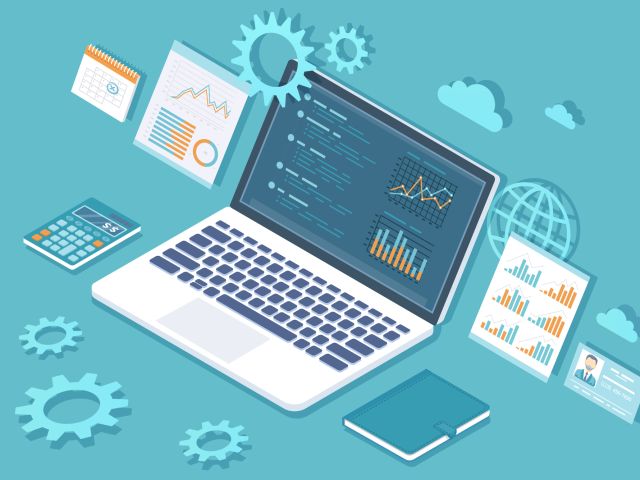No business owner/operator has ever said, “I can’t wait to get to the office to do some accounting!”. Maybe one or two, but they are few and far between. There are several basic best practices listed here that will ease your accounting problems as a small business owner. What should small business owners know about “number crunchers” in their role as financial managers? Where do we begin?

Most small business owners would rather focus on generating more revenue for their business than learning how to balance their books and learn the best practices of small business accounting. Some small business owners find it more beneficial to hire an accountant to handle their accounting. We will discuss that option later in an article, but for many small business owners, accounting falls on their shoulders. You should know a few basic best practices for small business accounting if you find yourself in this situation.
Below is a list of small business accounting best practices:
- Become familiar with basic accounting terms
- Select the right accounting software
- Track expenses
- Using resources for basic small business accounting
For small business accounting, familiarizing yourself with basic accounting terms is the first and most important step. Knowing what the following terms mean is essential to your small business accounting journey.
Asset
When you begin to handle your small business’ bookkeeping, you will encounter the term “asset”. A company’s asset is anything that can be converted into cash. Your assets will be primarily things that support your company’s growth and production. As an example, if you run an HVAC field service business and own the work vans you use for HVAC services, each van and the machinery used for HVAC services would be assets. If your business owns office equipment, the building itself, and the land it is located on, these can be considered assets. Long-term assets are what we just described as fixed assets. These are tangible assets that can be handled. As opposed to “current assets,” which are equivalent to cash or are easily converted to cash during a fiscal year. Treasury bills and certificates of deposit would be considered “current assets” if they are owned by your company. Inventory and accounts receivable are other examples. It is important to understand what your company’s assets are to gain an understanding of the health of your company and how it is managing its resources.
Liabilities
You must define ‘liabilities’ next. What exactly are liabilities? Liabilities are any debts owed by your business. These can include mortgages, bank loans, accounts payable, unpaid wages, and unpaid bills. Liabilities can also be grouped into two groups, long-term and current. Current liabilities are due within the next 12 months, whereas long-term liabilities won’t be due for another year. Liabilities will give you an idea of how “liquid” your business is, or whether you can pay off your debts.
Owner’s Equity
Owner’s equity is a bit more complicated than the other terms we’ve discussed. In the end, it is what is left after liabilities are subtracted from total assets, and it includes many different components, such as the owner’s contribution (your personal investments in the business), company earnings, and money taken from company funds by anyone authorized to do so (commonly referred to as a drawing). You can begin to understand the accounting equation that we will discuss later in this article once you understand the previous 3 concepts. In the meantime, let’s talk about some basic terms you need to know!es of deposit would be considered “current assets” if they are owned by your company. Inventory and accounts receivable are other examples. It is important to understand what your company’s assets are to gain an understanding of the health of your company and how it is managing its resources.
The Accounting Equation
Understanding your business’ health requires understanding its accounting equation. The accounting equation is as follows:
Assets = Liabilities + Owner’s Equity
It is easy to know when something is amiss with your books when you are aware that this equation exists. In the widely accepted double-entry bookkeeping method, this equation should remain balanced, meaning that the amount of one side of the equation equals the amount of the other. Look closely at your books and find out where the discrepancy lies if there is an imbalance.
General Ledger
Those who have studied accounting and used the double-entry bookkeeping method understand what the “general ledger” means, but someone just getting started might not understand. You will use the general ledger to track all business transactions in your company. Maintaining precise records in your general ledger will help you track where your money is going and where it has come from as your company conducts business. In the future, you will need to build any sort of financial statement based on it. It is the foundation of your company’s accounting system. A double-entry bookkeeping system for accounting involves corresponding debit and credit entries in the general ledger for each credit entry. This allows you to keep your records balanced and find errors more easily. The ledger is broken down based on your company’s chart of accounts into subledgers or accounts so that you can see how funds are flowing through your business. Do you know what a chart of accounts is? Later in this article, we will cover the concept in greater detail, but in short, your company’s chart of accounts is how you separate and record revenue, expenses, assets, liabilities, and equity. You must keep records using debits and credits in a general ledger, which we will discuss next!
Debits and Credits
Debits are records of money flowing into an account, while credits are records of money flowing out. In double-entry bookkeeping, each debit transaction must be balanced with a credit transaction. In your general ledger, you have a cash account and an equipment account. You purchase $1000 worth of new equipment for your company’s workshop. In order to keep your books balanced, you would need to enter a credit record of $1000 into your cash account showing that the machinery was paid for. You would then need to enter a debit record for $1000 into your equipment account indicating that you now have $1000 worth of equipment. When you add equity and debt accounts to this concept, it gets a bit more complicated, but this article from Bench.co explains it in an easy-to-understand way.
Revenue & Income
A company’s revenue is the amount of money it generates from the goods and services it offers. Similarly, income is determined by subtracting various expenses from the total revenue, such as manufacturing and labor costs. For example, suppose your company sold $10,000 worth of services last month. In other words, you earned $10,000. If you had to pay $2000 to your technicians and $1000 for advertising that month, your income would be $7000 ($10,000 revenue – $3000 expenses). Investopedia goes into more detail about the difference between revenue and income.
Expenses
The last topic briefly discussed expenses, but to clarify a little more, expenses are generally defined as the cost of doing business. It is likely that the building where you conduct your business requires electricity, water, and perhaps security. The cost of doing business at that location is a monthly expense you have to pay. This also applies to office supplies and advertising. When expenses start to climb, they can become murky. Let’s say you buy your dispatchers new computers and office furniture. Should you record these as expenses or assets? You will need to make this decision as a business, usually by setting a cap on the cost of expenses. Anything that costs less than $1000 will be recorded as an expense, and anything that costs more will be recorded as an asset. It all boils down to how you want your books to look, and there is no set formula for deciding where your cap limits should be set.
Use Accounting Software
We have just covered the basic HVAC small business accounting terms, so let’s move on to the next best practice which is to use accounting software. A variety of software options are available to assist with all of these concepts. As a small business, you’ll need software that can do everything all in one place. When selecting accounting software, ease of use is often the most important factor. QuickBooks is the easiest accounting software to use, which is why it is our top recommendation for small businesses.
Both QuickBooks’ online and desktop applications have a tremendous track record with small field service businesses. Accounting software like QuickBooks stands out due to its flexibility, as it allows you to accomplish virtually everything described and defined in the previous section of this post. With QuickBooks, you can do everything from generate invoices to track bills and expenses to print financial statements for your small business. And with the online version of QuickBooks, you can do these tasks from anywhere!
For nearly 30 years, QuickBooks has helped organizations balance their finances, and their product gets better every time. Small business owners can take advantage of their most comprehensive suite of accounting software features. Having the ability to handle payroll, track inventory, scan receipts, and generate advanced reports all in one place is extremely time-saving for a small business owner. The fact that QuickBooks has been around for so long also means that there are a lot of helpful community-driven resources that can assist you with just about any QuickBooks task.
Use Scheduling Software
If I told you that QuickBooks could be turned into a powerful field service management tool, would you believe me? It’s true! You can do it easily! The combination of QuickBooks and SAWIN Service Automation will take QuickBooks to a whole new level!
The SAWIN Service Automation application integrates directly into your QuickBooks file, providing features such as employee tracking, routing, and customer equipment management. These, along with other features, will simplify the management of your field service company. Customers from your company file can be imported into SAWIN and you can schedule jobs using their drag-and-drop scheduler. You won’t need to juggle cells and spreadsheets to schedule jobs, as the scheduler will show you who is available to handle customer jobs.
Make your daily schedule as efficient as possible
You can also optimize the daily schedule for your field service business with SAWIN Service Automation. By doing so, you can ensure you are dispatching the right team member to each job.
Make sure your technicians can work efficiently
With the SAWIN Service Automation mobile app, your technicians will have access to all kinds of customer and job information that your dispatch team or other technicians have gathered about your customers, even before they arrive on site. When you have a customer that has multiple units that your team services regularly, SAWIN will give your team the power to record the make, model, serial number, location, and any other pertinent information about each of your customer’s units so that everyone on your team can reference or review it later.
Track Expenses
Keeping your accounts separate is important
In order to properly manage your small business’s accounting books, tracking expenses is crucial. If you track expenses correctly, your company will save time and money, and it is not hard to do! To properly manage your field service business’s expenses, you need to keep your personal and business accounts separate. That means setting up completely separate bank accounts and credit cards. Every purchase must be accompanied by prudent management of which accounts are used. If you use your personal account to purchase business items and vice versa, then having separate accounts is meaningless. Separating your accounts is extremely important because it will drastically reduce the time you spend auditing your business spending if you need to find deductible business expenses. Rather than searching through filing cabinets and folios to find receipts for transactions made months ago, you can view every transaction your business has made online in just a few clicks. You can accomplish this only by keeping your personal and business accounts completely separate. Your business’ tax returns will also be less likely to generate legal issues if your tax accounts are kept separate. The tax return for your field service business cannot include personal expenses; if you fail to adhere to this rule, you could owe up to 75% more tax. It is easy to separate accounts, and it can save you a lot of money in the future!
Maintain a record of all expenditures
Keeping track of your small business’s expenses is an easy practice, as I mentioned earlier. Most people just assume they are doing it correctly when in reality they are missing steps that will cost them money and time in the long run. Recording every single expense is an easy step to overlook. You should record every transaction your company makes, no matter how small. Even though each small transaction may seem insignificant, together they can contribute to considerable tax savings during tax filing. Typically, credit card transactions are recorded online on the bank’s website, so it is easy to track each one. Most field service business owners fail to track every cash transaction. Due to the requirement to keep receipts, these are difficult to track. You can alleviate this problem by entering all cash receipts as transactions in your accounting software at the end of every day. When tax season comes around, following a routine like this will save you time and make sure you aren’t losing money.
Creating a routine or schedule for auditing your expenses is the most important step to tracking expenses. It should be done on a regular basis. Make sure, for example, that all cash receipts are entered into your accounting software at the end of each workday. Ensure that you did not include any personal transactions along with your business transactions at the end of the week. Audit your audits at the end of every month or quarter, which means you double-check random receipts you have lying around the office or at home and make sure they are all entered. It is also a good time to review your personal accounts for any business transactions you may have made and enter them accordingly into your accounting software. You can rest assured that your numbers will be accurate and complete at the end of the year, because you tracked all of your business expenses diligently!
Use a Reputable Resource
Using resources for small business accounting information is the last basic best practice for small business accounting. For field service business owners, this is a must, but it can be difficult to know where to begin. Don’t panic! Here are some helpful tips! You can find all the information you need to answer most of your questions regarding small business accounting in the following resources.
Using Quickbooks Community
The QuickBooks Community is a great resource for those who use QuickBooks (which we highly recommend). If you have any questions regarding QuickBooks, whether you use QuickBooks Online or the desktop application, this is the place to go. The page contains posts from other small business owners just like you, and since the community has been around so long, there is a good chance that any questions you may have, have already been answered by someone on one of the QuickBooks community threads. A ranking system in QuickBooks Community helps users feel confident about the answers provided by other users. Each answer can be rated according to its helpfulness, and the most helpful answers are displayed at the top of the thread. Those users who have provided the most helpful answers will be identified by badges they have earned over time, so you can trust that what they are saying is true. You can see exactly how other business owners are using QuickBooks in the real world by joining QuickBooks Community!
The blueprint
The Motley Fool provides the blueprint as a resource for small business owners. The Motley Fool has been a staple in the financial world for over a decade, and their content has generally received positive reviews. The blueprint consolidates the expertise of the entrepreneurs who work in a wide range of industries, from freelance photography to commercial crabbers. Their aim is to support their readers with information and advice that they have used to succeed in their businesses. As such, none of their articles are sponsored or inspired by advertisers! From accounting software to email marketing, they cover every aspect of running a small business.
Investopedia
Investopedia has offered financial information for over 20 years. Their content focuses on all things related to investments, as their name suggests. By providing educational information, they help their readers gain an understanding of the world of finance. The worlds of finance and small business ownership overlap in many areas, so you can find lots of helpful information on this site about small business accounting! There is a treasure trove of educational information on their website that will help you with in-depth, well-researched definitions of any terms you encounter while managing your small business’s books. In addition to their goal of educating, they make it easy to understand by providing information that can be digested in just a few minutes.
Conclusion
That’s all there is to small business accounting best practices! You might find handling accounting for your field service business to be a daunting task, but following the advice provided in this article and using the resources provided to fill in any gaps will enable you to handle accounting tasks for your small business.
We will discuss advanced topics such as specific accounting methods, reporting, and handling payroll in a later article. Stay tuned!
Booking that essential appointment can make or break your field service business. Imagine transforming every call into an opportunity—not just for a simple scheduled visit, but for building lasting relationships and driving growth in your organization. In this blog, we’ll unlock the secrets to turning mundane phone calls into powerful marketing tools.
Are you tired of he stress of overdue payments looming over your business and that sinking feeling every time an invoice goes unpaid? Say goodbye to collections agencies. Let’s dive into how modern invoicing solutions can revolutionize the way you manage finances while keeping your focus where it truly belongs: on growing your business!
Have you ever considered how those seemingly innocuous expenses—like travel time, equipment wear and tear, or unexpected overtime—can silently chip away at your bottom line? In this blog post, we’ll uncover these elusive budget busters and arm you with strategies to keep them in check.
Join us as we dive deep *Behind the Pipes* to explore five key differences between commercial and residential plumbing that could affect everything from installation costs to maintenance routines. This engaging guide will equip you with insights into how these distinct worlds operate—and why understanding them can save you time, money, and headaches down the line!
GET YOUR DEMO TODAY!
With over 37 years as a leader in field service management, it’s no wonder why service and installation businesses trust SAWIN for its personalized approach.





